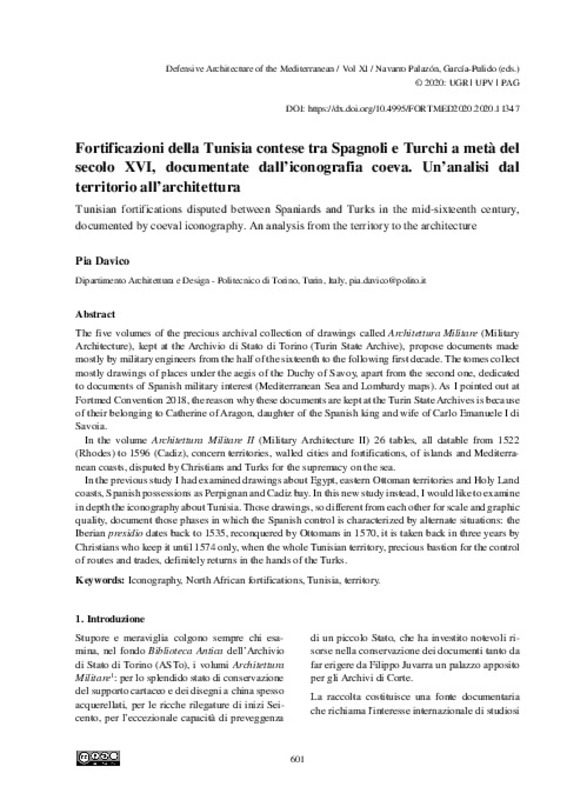JavaScript is disabled for your browser. Some features of this site may not work without it.
Buscar en RiuNet
Listar
Mi cuenta
Estadísticas
Ayuda RiuNet
Admin. UPV
Fortificazioni della Tunisia contese tra Spagnoli e Turchi a metà del secolo XVI, documentate dall’iconografia coeva. Un’analisi dal ter-ritorio all’architettura
Mostrar el registro sencillo del ítem
Ficheros en el ítem
| dc.contributor.author | Davico, Pia
|
es_ES |
| dc.coverage.spatial | east=9.537499; north=33.886917; name=Tunísia | es_ES |
| dc.date.accessioned | 2020-06-18T07:22:27Z | |
| dc.date.available | 2020-06-18T07:22:27Z | |
| dc.date.issued | 2020-05-15 | |
| dc.identifier.isbn | 9788490488560 | |
| dc.identifier.uri | http://hdl.handle.net/10251/146556 | |
| dc.description.abstract | [EN] The five volumes of the precious archival collection of drawings called Architettura Militare (Military Architecture), kept at the Archivio di Stato di Torino (Turin State Archive), propose documents made mostly by military engineers from the half of the sixteenth to the following first decade. The tomes collect mostly drawings of places under the aegis of the Duchy of Savoy, apart from the second one, dedicated to documents of Spanish military interest (Mediterranean Sea and Lombardy maps). As I pointed out at Fortmed Convention 2018, the reason why these documents are kept at the Turin State Archives is because of their belonging to Catherine of Aragon, daughter of the Spanish king and wife of Carlo Emanuele I di Savoia. In the volume Architettura Militare II (Military Architecture II) 26 tables, all datable from 1522 (Rhodes) to 1596 (Cadiz), concern territories, walled cities and fortifications, of islands and Mediterranean coasts, disputed by Christians and Turks for the supremacy on the sea. In the previous study I had examined drawings about Egypt, eastern Ottoman territories and Holy Land coasts, Spanish possessions as Perpignan and Cadiz bay. In this new study instead, I would like to examine in depth the iconography about Tunisia. Those drawings, so different from each other for scale and graphic quality, document those phases in which the Spanish control is characterized by alternate situations: the Iberian presidio dates back to 1535, reconquered by Ottomans in 1570, it is taken back in three years by Christians who keep it until 1574 only, when the whole Tunisian territory, precious bastion for the control of routes and trades, definitely returns in the hands of the Turks. | es_ES |
| dc.language | Italiano | es_ES |
| dc.publisher | Editorial Universitat Politècnica de València | es_ES |
| dc.rights | Reconocimiento - No comercial - Sin obra derivada (by-nc-nd) | es_ES |
| dc.subject | Fortifications | es_ES |
| dc.subject | Mediterranean | es_ES |
| dc.subject | Modern age | es_ES |
| dc.subject | Built Heritage | es_ES |
| dc.subject | Iconography | es_ES |
| dc.subject | North African fortifications | es_ES |
| dc.subject | Tunisia | es_ES |
| dc.subject | Territory | es_ES |
| dc.title | Fortificazioni della Tunisia contese tra Spagnoli e Turchi a metà del secolo XVI, documentate dall’iconografia coeva. Un’analisi dal ter-ritorio all’architettura | es_ES |
| dc.title.alternative | Tunisian fortifications disputed between Spaniards and Turks in the mid-sixteenth century, documented by coeval iconography. An analysis from the territory to the architecture | es_ES |
| dc.type | Capítulo de libro | es_ES |
| dc.type | Comunicación en congreso | es_ES |
| dc.identifier.doi | 10.4995/FORTMED2020.2020.11347 | |
| dc.rights.accessRights | Abierto | es_ES |
| dc.description.bibliographicCitation | Davico, P. (2020). Fortificazioni della Tunisia contese tra Spagnoli e Turchi a metà del secolo XVI, documentate dall’iconografia coeva. Un’analisi dal ter-ritorio all’architettura. Editorial Universitat Politècnica de València. 601-608. https://doi.org/10.4995/FORTMED2020.2020.11347 | es_ES |
| dc.description.accrualMethod | OCS | es_ES |
| dc.relation.conferencename | FORTMED2020 - Defensive Architecture of the Mediterranean | es_ES |
| dc.relation.conferencedate | Octubre 01-03,2020 | es_ES |
| dc.relation.conferenceplace | Granada, Spain | es_ES |
| dc.relation.publisherversion | http://ocs.editorial.upv.es/index.php/FORTMED/FORTMED2020/paper/view/11347 | es_ES |
| dc.description.upvformatpinicio | 601 | es_ES |
| dc.description.upvformatpfin | 608 | es_ES |
| dc.type.version | info:eu-repo/semantics/publishedVersion | es_ES |
| dc.relation.pasarela | OCS\11347 | es_ES |








